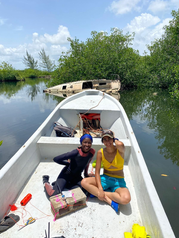
Social-Ecological Science
I investigate how environmental change shapes fisheries and coastal communities, pushing the boundaries of resilience science while centering equity and cultural connection to the sea.
EcoTrace Project
Tracking Metals from Sea to Shore
Investigating heavy metals across the food web in Placencia, Belize
Investigating heavy metal concentrations in Placencia, Belize, I lead the EcoTrace Project, a three-year, community-centered study of how metals move through a coastal food web — and how it shapes public perceptions of seafood safety. My approach combines ecotoxicology surveys and community interviews to build a holistic picture of ecosystem and human health. This work was developed during my time as a Washington Research Foundation Postdoctoral Fellow at the Padilla-Gamiño Lab, University of Washington School of Aquatic and Fishery Sciences (2023–2026).
Ecotoxicology
Working with local fishers, ocean leaders, and scientists (Crocodile Research Coalition & University of Belize), I sampled key species — from apex predators like Morelet’s crocodiles to Belize’s sea cucumber fisheries species — across lagoon, reef, and shoreline sites. This work helps understand variation in metals exposure and created a recent multi-month temperature dataset for these sites. These findings set environmental baselines and will guide the development of the Placencia Lagoon Management Plan.
Community Knowledge
Alongside community ambassadors (Monique Vernon, Dassia Regalado), I conducted surveys in English and Kriol to learn how residents rank pollution levels across Placencia. Long-time leaders in fishing, governance, and conservation shared their views, revealing how age, sector, and education influence perceptions. These insights reflect ecological and cultural realities as much as ecological survey data.

-
3 ecosystem zones studied
-
16 community leaders interviewed
-
283 bio-samples across the food web



Funders: Washington Research Foundation Postdoctoral Fellowship,
University of Washington, School of Aquatic and Fishery Sciences (2023-2026).
Imprinting Futures

A Salmon Science & Stewardship Project
Salmon, Science, and the Stories We Carry
*This project has not yet been initiated. Prospective plans are outlined below.
Over the next two years (2026-2028), I will lead Imprinting Futures, a kickstarter initiative in collaboration with The Carkeek Watershed Community Action Project (CWCAP) that will dive into the ways salmon — and people — are shaped by early experiences. Just as young salmon “imprint” on the scent of their home waters, we’re also asking how formative moments in nature might set the course for a lifetime of stewardship.
We’re taking action through four connected threads:
-
Tracking Water Quality & Salmon Returns — Analyzing over a decade of stream data from Carkeek Park to link water health with salmon return rates
-
Following Career Pathways — Investigating whether salmon stewardship sparks long-term engagement in science and conservation careers
-
Monitoring Salmon Fry — Piloting low-impact monitoring tools to compare survival rates of naturally spawned and pond-raised fry.
-
Adopt-a-Rain Garden — Partnering with neighbors, schools, and youth to incentivize rain gardens that reduce pollution and protect streams.
Our Place: Carkeek Park: Over four decades, CWCAP volunteers and leaders have brought salmon back to Pipers Creek — once dry of fish for 60 years. In 2023, more than 1,700 chum salmon returned in a single day, a program record. Each fish represents years of community effort restoring habitat, raising fry, and sharing the salmon story with thousands of visitors.

Mission & objectives for Imprinting Futures
Programs & community led monitoring of salmon at Piper's Creek, Carkeek Park

This new project builds on recent wins at Carkeek Park — asking new questions about how early environmental experiences shape lives, how our water quality affects return rates, and how neighbors can protect salmon beyond the park boundaries. I am currently seeking multi-year funding for 2026–2028 to expand monitoring, youth programs, and habitat restoration.
Salmon returns in Pipers Creek — a community-powered comeback (Seattle Times).


















